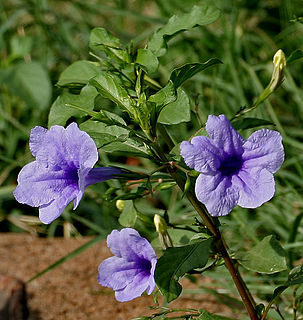
Acanthaceae is a family of dicotyledonous flowering plants containing almost 250 genera and about 2500 species. Most are tropical herbs, shrubs, or twining vines; some are epiphytes. Only a few species are distributed in temperate regions. The four main centres of distribution are Indonesia and Malaysia, Africa, Brazil, and Central America. Representatives of the family can be found in nearly every habitat, including dense or open forests, scrublands, wet fields and valleys, sea coast and marine areas, swamps, and mangrove forests.

In biology, a taxon is a group of one or more populations of an organism or organisms seen by taxonomists to form a unit. Although neither is required, a taxon is usually known by a particular name and given a particular ranking, especially if and when it is accepted or becomes established. It is very common, however, for taxonomists to remain at odds over what belongs to a taxon and the criteria used for inclusion. If a taxon is given a formal scientific name, its use is then governed by one of the nomenclature codes specifying which scientific name is correct for a particular grouping.

Ruellia is a genus of flowering plants commonly known as ruellias or wild petunias. They are not closely related to petunias (Petunia) although both genera belong to the same euasterid clade. The genus was named in honor of Jean Ruelle (1474–1537), herbalist and physician to Francis I of France and translator of several works of Dioscorides.

Ruellia brevifolia, the tropical wild petunia or red Christmas pride, is an ornamental plant in the family Acanthaceae. It is native to South America, from Colombia to southern Brazil and northern Argentina.

Ruellia simplex, the Mexican petunia, Mexican bluebell or Britton's wild petunia, is a species of flowering plant in the family Acanthaceae. It is a native of Mexico, the Caribbean, and South America. It has become a widespread invasive plant in Florida, where it was likely introduced as an ornamental before 1933.

Ruellia humilis is a species of flowering plant in the family Acanthaceae. It is native to the eastern United States. It is grown as an ornamental plant.
Ruellia capitata is a plant native to Cerrado vegetation of Argentina, Brazil, and Paraguay.

Ruellia geminiflora, known locally as ipecacuanha-da-flor-roxa, is a species native to Argentina; Brazil, typically Caatinga and Cerrado vegetation; Guianas, and Venezuela. The roots of this plant contains possibly toxic substances.

Ruellia puri is a plant native to the cerrado vegetation of Brazil.

Ruellia macrantha, or Christmas pride, is a plant native to the cerrado vegetation of Brazil, which is usually used as an ornamental plant. This plant is cited in Flora Brasiliensis by Carl Friedrich Philipp von Martius.
Ruellia diffusa is a plant native to the Cerrado vegetation of Brazil.
Ruellia dielsii is a species of plant in the family Acanthaceae. It is endemic to Ecuador. Its natural habitat is subtropical or tropical moist montane forests.
Ruellia dioscoridis is a species of plant in the family Acanthaceae. It is endemic to Yemen. Its natural habitats are subtropical or tropical dry shrubland and subtropical or tropical dry lowland grassland.
Ruellia insignis is a species of plant in the family Acanthaceae. It is endemic to Yemen.
Ruellia kuriensis is a species of plant in the family Acanthaceae. It is endemic to Yemen. Its natural habitat is subtropical or tropical dry shrubland.
Ruellia paulayana is a species of plant in the family Acanthaceae. It is endemic to Yemen.

Ruellia tuberosa, also known as minnieroot, fever root, snapdragon root and sheep potato, is a species of flowering plant in the family Acanthaceae. Its native range is in Central America but presently it has become naturalized in many countries of tropical South and Southeast Asia.

Jean Ruel, also known as Jean Ruelle or Ioannes Ruellius in its Latinised form, was a French physician and botanist noted for the 1536 publication in Paris of De Natura Stirpium, a Renaissance treatise on botany.
This page is based on this
Wikipedia article Text is available under the
CC BY-SA 4.0 license; additional terms may apply.
Images, videos and audio are available under their respective licenses.










